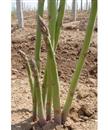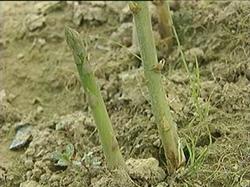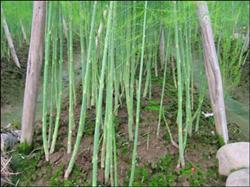Cultivation techniques of asparagus intercropping with vegetables

The cultivation of asparagus requires large row spacing. In the open field of newly planted asparagus, some dwarf vegetables can be planted between rows to achieve more than one year harvest and achieve the goal of high yield and commercial efficiency. Pomegranate Town, Donghai County, Jiangsu Province, has been cultivated in this mode since 1995, with an output value of more than 10,000 yuan per mu. 1. Cultivation and management of asparagus 1. Variety selection. Asparagus varieties with high quality and high yield are Mary Washington 500, Mary Washington 500W, California 72, California 873, Lu asparagus 1, asparagus King and so on. It can be chosen according to the local situation. 2. Sowing and raising seedlings. The seeds can be sown when the ground temperature is more than 10 ℃ at the lower 5 cm, and it is suitable for sowing from May to June. Prepare the seedbed according to the ratio of the seedbed to the field at 1:10-12. Before sowing, remove the seeds floating on the water with clean water, and then soak the seeds with Uspuron 1000 times solution for 12-24 hours. The seeding bed is 1.2-1.5 meters wide. Transverse trenches are opened every 40 cm, with a depth of 2 cm. Sow 1 seed every 7-10 cm in the ditch, cover fine soil 2 cm thick, and cover wheat straw 3-5 cm thick. For each mu of field planted, use 400-500 grams of seeds. When 60% of the seeds emerge, remove the wheat straw. When the seedling height is 10-15 cm, 41 kg of urea and 3 kg of potassium chloride are applied per mu, and then watered after withdrawal. After that, topdressing once a month, and the last time in mid-September. 3. Land preparation and planting. 4000 kg of rotten organic fertilizer is applied per mu, with a depth of 25-30 cm. Rake the ground flat. For those who harvest white asparagus, one trench shall be opened every 1.8 ~ 2 meters, and for those who harvest green asparagus, one trench shall be opened every 1.5 meters. The groove is 30-40 cm deep and 50-60 cm wide. Per mu furrow, 2000 kg ~ 3000 kg of rotten ring fertilizer, 30 kg-50 kg of calcium perstetrate, 10 kg of potassium chloride and 15 kg of ammonium sulfate were applied, and mixed well with the soil and trampled on. Spread another layer of soil 8 centimeters thick and you can plant seedlings. The colonization was carried out from October to November or from the end of February to the first ten days of March. When planting, cut the aboveground stem short, leaving 20 cm. The distance between plants is 40 cm, and the soil cover is 5-6 cm thick. Later, combined with forced fertilizer and hoe, the root disk will be buried 10 cm deep underground. 4. Manage in the field. More organic fertilizer should be applied to the cultivation of asparagus. After annual harvest, 1500 kg-2000 kg of ring fertilizer, 5 kg-8 kg of urea, 30 kg-40 kg of superphosphate and 15 kg of potassium chloride are applied per mu. Bury the fertilizer in the soil. In the first and middle of August, 1000 kg of human feces and urine (or 10 kg of urea), 30 kg of calcium superphosphate and 15 kg of potassium chloride were applied once more. During harvest, there should be a certain amount of moisture in the soil. Waterlogging should be drained in time in the rainy season. Paddle in time after watering or rain. Those who harvest white asparagus cultivate the soil before the young stems grow in spring. In the first and middle of March, the soil was cultivated when the soil temperature reached more than 10 ℃ at the lower 10 cm. The depth of soil cultivation is 15 cm. The harvest began 10-15 days after soil cultivation. After harvest, immediately peel off the soil and expose the rhizome for 2-3 days, combined with the first topdressing to restore the ground to the state before soil cultivation. In order to prevent waterlogging and ventilation, the soil around the plant can be slightly higher than the soil surface between the rows. 5. Pest control. The main diseases of asparagus are stem blight, brown spot, root rot, blight and so on. In winter, when the aboveground stems wither, they should be pulled out, the dead branches and leaves should be cleaned and burned away from the land. It is necessary to plough and weed in time. Timely drainage in the rainy season, so that the soil is always in a dry-wet state. When the young stem is 10 cm high, spray 0.5% Mel 0.7% Bordeaux solution, or 50% carbendazim wettable powder 800-1000 times, or 75% chlorothalonil wettable powder 800-1000 times. Spray every 10 days from now on. Give priority to prevention. Once the disease occurs, it can be sprayed with 64% disinfectant alum 1000 times solution to control. "the main underground pests of asparagus are ground tigers, golden needles, grubs and so on. The pests harming the aboveground parts are Spodoptera litura and thrips. Poison baits can be used to kill underground pests, and chrysanthemum pesticides can be sprayed to control ground pests. 2. Management of intercropping vegetables 1. Overwintering spinach. Sow seeds from mid-September to late November. Sow 4 rows of asparagus between rows, and the row is 10 cm x 15 cm. Harvest in the middle and late March. 2. Flower coconut lai in spring and summer. In the middle of March, a small arch shed was used to cultivate mu. After the asparagus was harvested in late April, it was planted in the rows of asparagus, with a spacing of 40 cm x 40 cm, and was harvested from late June to early July. If the green asparagus is harvested, the sowing and planting time of broccoli can be 20-25 years ahead of schedule. Broccoli can also be changed to dwarf kidney beans, or dwarf vegetables such as spring and summer Chinese cabbage, heading lai, dwarf tomatoes and cumin. In the next crop, dwarf autumn vegetables can be cultivated, such as purple cabbage, black five-field carrots, raw radish and canister and other vegetables. In particular, the planting of green leafy vegetables can be timely adjusted according to the market in order to obtain higher economic benefits.
- Prev

Occurrence and control of stem rot of asparagus
1. Symptom characteristics asparagus stem rot mainly harms young bamboo shoots. The young bamboo shoots may be damaged after they are unearthed, and the young stems appear water-like amorphous disease spots, which expand around the stem, resulting in stem tissue disintegration and decay, resulting in the death of young bamboo shoots. If the disease is light, even if it does not wither and die, its growth potential is greatly reduced, the aboveground stems and leaves are weak, the young stems are weak, and the yield.
- Next

High-yield cultivation and management techniques of asparagus
Asparagus is one of the highly efficient cash crops, which can be harvested for more than 10 years at one time. The annual harvest of bamboo shoots per mu is generally 2300 kg, and the output value per mu is more than 10,000 yuan. Fresh bamboo shoots are rich in protein, cellulose and a variety of trace elements, which have the effects of promoting blood circulation, promoting menstruation and preventing cancer. Its high-yield cultivation and management techniques should be grasped as follows.
Related
- Where is it suitable to grow horseradish in China? it is expected to see the middle altitude horseradish in Alishan.
- How to prevent tomato virus disease reasonably? (Control methods included)
- Many people like to plant towel gourd on the balcony. What are the main points of this method and management?
- What crops can chili peppers be mixed with?
- Fertilization techniques and matters needing attention in Tomato
- What are the grafting techniques for peach seedlings in spring?
- Harm and control methods of root swelling disease of Chinese cabbage
- What are the pests of sweet potatoes? How to prevent and cure it?
- Symptoms, causes and Control methods of navel Rot in Tomato
- The cause of "Cucumber rotten bibcock" in Farmers' planting Cucumber and its Control Plan

